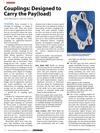Couplings: Designed to Carry the Pay(load)
Couplings: Designed to Carry the Pay(load)
Couplings. There certainly is no shortage of couplings — or things to couple them with. There also seems to be no lack of applications for them. You say you need to reduce the transmission of shock loads from one shaft to another? That's a classic application for shaft couplings; but really, couplings are application-intensive. They're everywhere.
A coupling is defined as a device that links two shafts together at their ends for transmitting power. If designed and installed correctly, couplings do not typically allow disconnection of these shafts during operation. However, there are — and this is just one example — torque-limiting couplings that sometimes slip or disconnect when things get too, well — torquey — and a specified limit is exceeded. Indeed, the primary purpose of couplings is to join two pieces of rotating equipment while permitting some degree of misalignment or end movement — or both. (Think of coupled rail cars and how they bob and weave their way down straight and curved track.) By careful design, best-for-application selection, and expert installation and robust maintenance of couplings, significant savings can be realized in reduced maintenance costs and downtime.
A partial list of coupling types includes:
Clamped or compression-rigid couplings are bi-sectioned and fitted around a shaft, thus forming a sleeve; flanged rigid couplings are intended for heavy loads or industrial equipment; a sleeve coupling is a pipe with a bore finished to the tolerance needed and to accommodate a specified shaft size; sleeve couplings feature case shaft ends that are, yes — coupled and fixed against each other and then encased by a muff or sleeve coupling.
Meanwhile, IMTS fever runs rampant, with exhibitors busy strategizing, finalizing booth design and doing whatever else it takes to ensure a good showing. But in an attempt to obtain a better grasp of today's coupling technology and some industry insight, we were very lucky to catch up with a couple of gracious-but-busy guys that made some time to answer a few questions for us. That would be John Malik, Altra Industrial Motion, couplings business development manager, and Andy Lechner, R+W America product manager, flexible vs. rigid Couplings.







